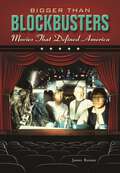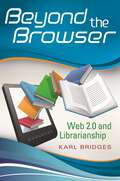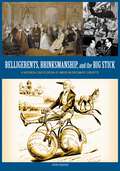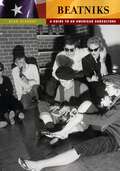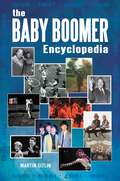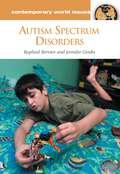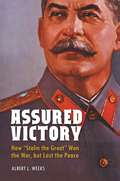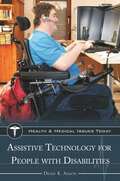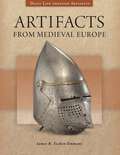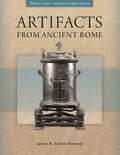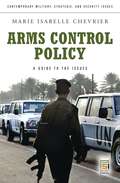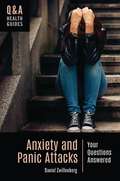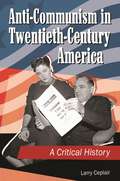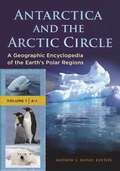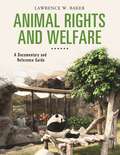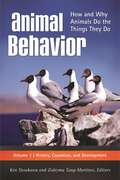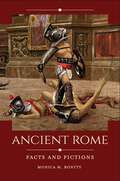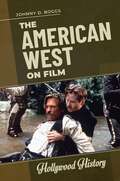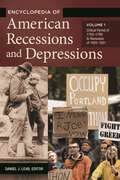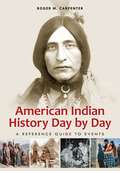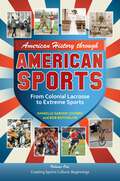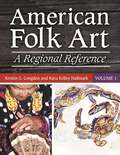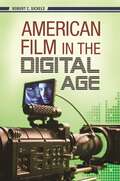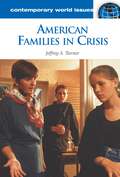- Table View
- List View
Bigger Than Blockbusters: Movies That Defined America
by James RomanWhether it's the hum drum existence of Marion Crane and her illicit love affair, the psychotic antics of Norman Bates, the sudden irrational migration of birds, a crop duster swooping down on Roger Thornhill in the middle of nowhere, or Vincent Vega and Mia Wallace's unforgettable dance at Jack Rabbit Slim's - they are all cinematic moments that forever changed the psyche and viewing experience of American audiences. Bigger Than Blockbusters: Movies That Defined America tells the stories behind the most significant and influential films in American culture, movies that have had a profound influence on the literary, cinematic and popular culture of our time.Arranged chronologically, the volume gives readers an opportunity to place the films within the context of the social and cultural historic dynamic of the time, making this an ideal source for student papers and reports. Each entry includes the filmmaker, actors, release information, a synopsis of the film, critics' reviews, awards, current availability, and then background on the making of the film in an artistic, economic, and technological context. Spanning all genres, including horror and drama, adventure, comedy, musicals, science fiction, and more, this volume is loaded with enough trivia and factoids to satisfy even the most die-hard movie buff. Also included are other Greatest Films compilations from the National Society of Film Critics and noteworthy sources for comparative purposes. Guaranteed to inspire forays into film favorites as well as some very lively debate, this resource is essential reading for film lovers and students alike.
Beyond the Browser: Web 2.0 and Librarianship
by Karl BridgesAuthored by an experienced librarian, digital resource manager, and professor in the field of library science, this book explores the wide-reaching impact of second-generation web technologies on library organization and services—and how library staff must respond.Most librarians are infinitely familiar with the Internet due to their daily use of this essential resource. However, having practical expertise with today's digital resources does not guarantee the ability to speak intelligently and convincingly about their less-obvious benefits to funding authorities—an important skill to have. Beyond the Browser: Web 2.0 and Librarianship overviews the history of libraries and the Internet to provide necessary perspective and then examines current and future trends in libraries. In Part I, the author traces the notion of connectivity from its roots in the 19th century through the rise of digital technology in the second half of the 20th, concluding with a discussion of its influence on the role expectations and performance of today's information professional. Part II investigates the evolutionary impact of open access, scholarly inquiry, and second-generation web technologies on library organization and services. A bibliography of helpful resources is also included.
Belligerents, Brinkmanship, and the Big Stick: A Historical Encyclopedia of American Diplomatic Concepts (Non-ser.)
by John M. DobsonThis encyclopedia offers authoritative coverage of the concepts, traditions, events, and individuals that shaped United States' foreign relations from the American Revolution to the present.Belligerents, Brinkmanship, and the Big Stick: A Historical Encyclopedia of American Diplomatic Concepts is the first comprehensive encyclopedic work to focus specifically on America's extraordinary history of political engagement with the world. With hundreds of alphabetically organized entries and a rich collection of primary sources, it offers a unique way of understanding the centrality of diplomacy and the role of foreign relations throughout U.S. history.The encyclopedia is divided into five chronological sections, each containing a brief introduction, topical entries, biographical portraits, and representative documents. It is designed to help readers gain a deeper understanding of both general ideas as well as specific policies like the Monroe Doctrine, the Open Door Policy, and Shuttle Diplomacy. By examining seminal events, important ideas, and individual contributions in the context of U.S. history, the encyclopedia reveals the underlying traditions and motivations of American foreign policy as it has evolved over time.
Beatniks: A Guide to an American Subculture (Guides to Subcultures and Countercultures)
by Alan BisbortThis is a revealing look at the events and personalities that defined the Beat Generation, drawing on over three decades of research.Beatniks: A Guide to an American Subculture gets readers past the caricature of the "beatnik" as a goateed, beret-wearing, bongo-playing poseur, drawing on extensive research to show just how profound an impact the beats had on American culture, politics, and literature. Beatniks conveys the complexity, influences, events, and places that shaped the Beat Generation from the late 1940s to the cusp of the 1960s. The book also features a series of essays on specific aspects of the subculture, as well as interviews with Beat Generation luminaries like Allen Ginsberg, Ann Charters, Roy Harper and Michael McClure. Throughout, readers will meet an extraordinary gallery of people both famous—Jack Kerouac, William Burroughs, Neal Cassady—and lesser known but no less fascinating, including Kenneth Patchen, Lord Buckley, Mort Sahl, Jack Micheline, Lew Welch, Joan Vollmer Adams, and Lenore Kandel. Also included is a detailed glossary with the origins and meanings of the beat lingo.
The Baby Boomer Encyclopedia
by Martin GitlinThis encyclopedia defines and contextualizes the Baby Boomer generation and the wide-reaching contributions of its members throughout modern American history.Comprising some 80 million Americans born between 1946 and 1965, the Baby Boomers have significantly changed every aspect of American history and culture. The members of this generation experienced some of the most tumultuous times in American history; indeed, the Boomers helped create these pivotal eras. From the advent of rock and roll to disco and rap, from the sexual revolution to the arrival of AIDS, and from race riots to the election of a black president, Baby Boomers have seen it all.Through nearly 100 alphabetically arranged entries, this encyclopedia gives later generations insight into the contributions of the Baby Boomers, and it helps members of that generation better contextualize their own experiences. Included entries are written in a clear and engaging manner, covering politics and activism, entertainment, the economy, gender roles, arts, pop culture, sports, religion, drug and alcohol use, and many other subject areas.
Autism Spectrum Disorders: A Reference Handbook (Contemporary World Issues)
by Raphael Bernier Ph.D. Jennifer GerdtsThis handbook provides an overview of the current scientific understanding of autism spectrum disorders, as well as a cultural and historical perspective on the controversies that plague the field."Autism" describes a complex developmental disability that interferes with social interaction and communication. Symptoms of autism are generally recognizable when children are under the age of three. Until the 1990s, rates for autism were generally estimated at 1 in 2500. In 2010, however, the estimate is now 1 in 110 children. Is the incidence of autism increasing, or has there simply been a shift in how often this disability is diagnosed as the problem?This text provides a comprehensive explanation of autism spectrum disorders (ASD). Autism Spectrum Disorders: A Reference Handbook educates readers about ASD without relying on confusing medical jargon, highlighting current understanding of etiology, neuroscience, and intervention. It also discusses the historical and cultural influences of ASD and explores the controversial aspects of autism.
Assured Victory: How "Stalin the Great" Won the War, but Lost the Peace
by Albert L. WeeksThis book documents dictator Joseph Stalin's brilliant tactics as well as missteps in taking preemptive actions that guaranteed ultimate victory over the German invaders. It also covers the policies implemented after the war that made the Soviet Union a menace to world peace and led to collapse of Soviet rule.A detailed reexamination of historical facts indicates that Stalin could deserve to be regarded as a "great leader." Yet Stalin clearly failed as his nation's leader in a post-World War II milieu, where he delivered the Cold War instead of rapid progress and global cooperation. It is the proof of both Stalin's brilliance and blunders that makes him such a fascinating figure in modern history.Today, most of the Russian population acknowledges that Stalin achieved "greatness." The Soviet dictator's honored place in history is largely due to Stalin successfully attending to the Soviet Union's defense needs in the 1930s and 1940s, and leading the USSR to victory in the war on the Eastern Front against Nazi Germany and its allies. This book provides an overdue critical investigation of how the Soviet leader's domestic and foreign policies actually helped produce this victory, and above all, how Stalin's timely support of a wartime alliance with the Western capitalist democracies assured the defeat of the Axis powers in 1945.
Assistive Technology for People with Disabilities (Health and Medical Issues Today)
by Denis K. AnsonHow would you make a phone call or send email if you couldn't hear, see, or use your hands? This book shows how assistive technology helps individuals with disabilities perform tasks that people without disabilities may take for granted.Assistive technology can be used in two ways: to help people with disabilities to do things that people without disabilities can do without technology, and to improve access to everyday technology that is not designed for people with disabilities. In both cases, the focus is on matching individuals with the tools best suited to fill their needs. A part of Greenwood's Health and Medical Issues Today series, Assistive Technology for People with Disabilities explores what technologies are available to individuals with disabilities, what they can help them to accomplish, and potential hurdles to their use that must be overcome. It explores this exciting field broadly and in depth while still keeping the "people-first" mindset that is the hallmark of assistive technology. In addition, it provides guidance and resources for individuals seeking assistive technology for themselves or for a loved one.
Artifacts from Medieval Europe (Daily Life through Artifacts)
by James B. Tschen-EmmonsUsing artifacts as primary sources, this book enables students to comprehensively assess and analyze historic evidence in the context of the medieval period.This new addition to the Daily Life through Artifacts series provides not only the full benefit of a reference work with its comprehensive explanations and primary sources, but also supplies images of the objects, bringing a particular aspect of the medieval world to life. Each entry in Artifacts from Medieval Europe explains and expands upon the cultural significance of the artifact depicted. Artifacts are divided into such thematic categories as domestic life, religion, and transportation. Considered collectively, the various artifacts provide a composite look at daily life in the Middle Ages. Unlike medieval history encyclopedias that feature brief reference entries, this book uses artifacts to examine major aspects of daily life. Each artifact entry features an introduction, a description, an examination of its contextual significance, and a list of further resources. This approach trains students how to best analyze primary sources. General readers with an interest in history will also benefit from this approach to learning that enables a more complete appreciation of past events and circumstances.
Artifacts from Ancient Rome (Daily Life through Artifacts)
by James B. Tschen-EmmonsWhen Roman objects and artifacts are properly analyzed, they serve as valuable primary sources for learning about ancient history. This book provides the guidance and relevant historical context students need to see relics as evidence of long-past events and society.Artifacts from Ancient Rome is a unique social history that explores major aspects of daily life in a long-ago era via images of physical objects and historical information about these items. This book also affords "hands-on training" on how to approach primary sources.The author—a historian also trained as an archaeologist—begins by explaining the concept of using artifacts to understand and "see" the past and providing a primer for effectively analyzing artifacts. Entries on the artifacts follow, with each containing an introduction, a description of the artifact, an explanation of its significance, and a list of further sources of information. Readers of the book will not only gain a composite impression of daily life in ancient Rome through the study of artifacts from domestic life, religion, war, transportation, entertainment, and more, but will also learn how to best understand and analyze primary sources for learning.
Arms Control Policy: A Guide to the Issues (Contemporary Military, Strategic, and Security Issues)
by Marie Isabelle ChevrierIn this work, an expert on biological weapons offers a thoughtful examination of the political and technical issues that have affected the implementation of arms control agreements from the 1960s to the present.Arms Control Policy: A Guide to the Issues examines the history of the major arms control treaties since the early 1960s. It offers readers a broad understanding of the ways in which arms control agreements were negotiated and implemented during the Cold War, the international and national events that affected treaty negotiation and implementation, and how the arms control landscape has changed in the war's aftermath. Specifically, the handbook overviews the obligations contained in bilateral U.S.-Soviet/Russian and multilateral arms control agreements covering nuclear and nonnuclear weapons. It also treats such agreements as the Biological Weapons Convention, the Chemical Weapons Convention, the Treaty to Ban Land Mines, and the Treaty to Ban Cluster Munitions. The book concludes with a look at the current challenges in the implementation of arms control agreements and the future of arms control.
Anxiety and Panic Attacks: Your Questions Answered (Q&A Health Guides)
by Daniel Zwillenberg PsyDA new title in the Q&A Health Guides series, this book tackles readers' questions regarding anxiety and panic attacks, dispelling misconceptions and examining real-world scenarios that highlight important concepts and controversies.How is social anxiety different from shyness or introversion? Are anxiety disorders only a problem in the Western, industrialized world, and if not, are they expressed differently in other cultures? Why do some people suffer from panic attacks while others do not? What kinds of therapy and medication are available for anxiety? What happens in therapy? How can well-meaning family and friends help a person with an anxiety disorder rather than make things worse? Anxiety and Panic Attacks: Your Questions Answered addresses all of these topics and much more, presenting information in a question-and-answer format that makes finding the desired information easy. The book begins with a "Guide to Health Literacy" section that explains what health literacy is and provides readers with tools to improve their health literacy, and then examines five myths and misconceptions about anxiety and supplies five case studies that provide real-world context and reinforce the concepts discussed in the book. All of the Greenwood Q&A Health Guides series books are specifically designed to provide readers with authoritative yet accessible answers to their questions in a concise, targeted resource that they can trust to be medically accurate.
Anti-Communism in Twentieth-Century America: A Critical History
by Larry CeplairThis compelling, critical analysis of anti-communism illustrates the variety of anti-Communist styles and agendas, thereby making a persuasive case that the "threat" of domestic communism in Cold War America was vastly overblown.In the United States today, communism is an ideology or political movement that barely registers in the consciousness of our nation. Yet merely half a century ago, "communist" was a buzzword that every citizen in our nation was aware of—a term that connoted "traitor" and almost certainly a characterization that most Americans were afraid of.Anti-Communism in Twentieth-Century America: A Critical History provides a panoramic perspective of the types of anti-communists in the United States between 1919 and the collapse of the Soviet Union. It explains the causes and exceptional nature of anti-communism in the United States, and divides it into eight discrete categories. This title then thoroughly examines the words and deeds of the various anti-Communists in each of these categories during the three "Red Scares" in the past century. The work concludes with an unapologetic assessment of domestic anti-communism. This book allows readers to more fully comprehend what the anti-communists meant with their rhetoric, and grasp their impact on the United States during the 20th century and beyond—for example, how anti-communism has reappeared as anti-terrorism.
Antarctica and the Arctic Circle [2 volumes]: A Geographic Encyclopedia of the Earth's Polar Regions [2 volumes]
by Andrew J. HundThis one-stop reference is a perfect resource for anyone interested in the North and South Poles, whether their interest relates to history, wildlife, or the geography of these regions in the news today.Global warming, a hot topic among scholars of geography and science, has led to increased interest in studying the earth's polar ice caps, which seem to be melting at an alarming rate. This accessible, two-volume encyclopedia lays a foundation for understanding global warming and other issues related to the North and South Poles. Approximately 350 alphabetically arranged, user-friendly entries treat key terms and topics, important expeditions, major figures, territorial disputes, and much more.Readers will find information on the explorations of Cook, Scott, Amundsen, and Peary; articles on humpback whales, penguins, and polar bears; and explanations of natural phenomena like the Aurora Australis and the polar night. Expedition tourism is covered, as is climate change. Ideal for high school and undergraduate students studying geography, social studies, history, and earth science, the encyclopedia will provide a better understanding of these remote and unfamiliar lands and their place in today's world.
Animal Rights and Welfare: A Documentary and Reference Guide (Documentary and Reference Guides)
by Lawrence W. BakerThrough the use of primary source documents, readers can learn about key opinions and legislation in the important field of animal rights and welfare—a current and highly relevant topic.Animal Rights and Welfare: A Documentary and Reference Guide addresses a broad range of key topics within the subject of animal rights and welfare, including zoos, animal testing, philosophy regarding the treatment of animals, and practical measures instituted to protect animals, supplying readers with an impartial and authoritative resource for understanding the history of animal rights and the issues that dominate discussions about animal rights. Organized chronologically, the book discusses topics such as animal rights within the context of hunting for food, pelts, and other body parts, as well as for recreation; working animals; animals used for education or scientific and medical research; animals in the fashion and entertainment industries; and the food industry.The text provides reproductions of dozens of carefully selected primary documents from the time of Aristotle (B.C.) to present day to engage readers and provide opportunities for them to apply their critical thinking and analysis skills. The text of each document is introduced by a headnote to place it in context and concludes with analysis that details its significance and clarifies specific passages when needed. Each document or excerpt is followed by a full citation of the document.
Animal Behavior [3 volumes]: How and Why Animals Do the Things They Do [3 volumes]
by Alison M. Bell Andrew P. King Anna Dornhaus Anne Danielson-François Anthony C. Little Benedict C. Jones Bennett G. Galef Brett M. Gibson Brian Keane Bronwyn H. Bleakley Çağlar Akçay Carolynn L. Smith Catherine A. Marler Charles T. Snowdon Christopher D. Watkins Christopher Harshaw Christopher S. Evans David B. Mcdonald David Clark David Crews David F. Sherry David J. White Douglas W. Mock Geoffrey E. Hill George Uetz Guillermo Paz-Y-Miño-c James L. Gould Janis L. Dickinson Jason Low Jeffrey R. Alberts Ken Yasukawa Kenyon B. Mobley Laura Smale Lee Alan Dugatkin Lee C. Drickamer Lisa M. Debruine Mark E. Hauber Matthew J. Fuxjager Megan Hastings Hagenauer Meredith J. West Michael D. Beecher Michael J. Ryan Michelle Pellissier Scott Nancy G. Solomon Rachel A. Page Renée A. Duckworth S. Craig Roberts Sarah Jane Alger Sean P. Bradley Terry J. Ord Theodore Stankowich Walter D. Koenig Ximena E. Bernal Zenobia Lewis Zuleyma Tang-MartínezDiscover why animals do what they do, based on their genes, physiologies, cultures, traditions, survival and mating advantages, and evolutionary histories—and find out how studying behavior in the animal world helps us understand human behavior.The three volumes of Animal Behavior: How and Why Animals Do the Things They Do cover the breadth of the field, addressing causation, development, function, and evolution in a wide range of animals, from invertebrates to humans. Inspired by Nobel laureate Nikolaas Tinbergen's work, the first two volumes follow Tinbergen's four classic questions of animal behavior, while the third volume supplies integrated examples of Tinbergen's investigative process applied in specific cases.Written in an engaging, accessible manner ideal for college students as well as general audiences, this evidence-based collection provides a fascinating tour of animal behaviorists' findings, such as how animal communication can be truthful or deceitful, the deadly serious business behind clashes in the "battle of the sexes," and how documentation of animal behavior can lead to a deeper understanding of human behavior. Each chapter provides both historical background and information about current developments in animal behavior knowledge.
Ancient Rome: Facts and Fictions (Historical Facts and Fictions)
by Monica M. BonttyThis book shares little-known facts from and excerpts of primary source documents to correct popular misconceptions about Ancient Rome and to show how those misconceptions became widespread.Roman personalities and history have always had a larger-than-life profile in American popular culture, but most people think of this ancient civilization as merely decadent, cruel, and elitist. Most of our stereotypical conceptions of the empire and its people, however, are wrong. This book corrects popular misconceptions about the ancient Roman world, thus making ancient history relevant and accessible to modern readers and allowing modern critics of American politics and society to draw accurate comparisons.Each chapter discusses how a particular misconception developed, spread, and evolved into what we now believe to be the historical truth. Topics discussed include crucifixion, the destruction of Carthage, Julius Caesar's last words, and Roman hygiene. Excerpts from primary source documents provide evidence of both the rise of the historical fictions and the truths behind the myths.
The American West on Film (Hollywood History)
by Johnny D. BoggsMore than a history of Western movies, The American West on Film intertwines film history, the history of the American West, and American social history into one unique volume.The American West on Film chronicles 12 Hollywood motion pictures that are set in the post–Civil War American West, including The Ox-Bow Incident, Red River, High Noon, The Searchers, The Magnificent Seven, Little Big Man, and Tombstone. Each film overview summarizes the movie's plot, details how the film came to be made, the critical and box-office reactions upon its release, and the history of the time period or actual event. This is followed by a comparison and contrast of the filmmakers' version of history with the facts, as well as an analysis of the film's significance, then and now.Relying on contemporary accounts and historical analysis as well as perspectives from filmmakers, historians, and critics, the author describes what it took to get each movie made and how close to the historical truth the movie actually got. Readers will come away with a better understanding of how movies often reflect the time in which they were made, and how Westerns can offer provocative social commentary hidden beneath old-fashioned "shoot-em-ups."
Encyclopedia of American Recessions and Depressions [2 volumes]: [2 volumes]
by Daniel J. LeabA riveting look at the financial cycles in American economic history from colonial times to the present day, with an eye on the similarities and differences between past and present conditions as analyzed by leading economic historians.The United States has emerged from the financial chaos of its last economic crisis, yet still very few sources place the events of the modern era within the context of financial downturns of the past. An examination of the trends and patterns of previous depressions and recessions may allow us to recognize—and avoid—the behaviors and practices that prolonged the fiscal problems of previous generations. This thought-provoking encyclopedia presents an overview of notable economic events, their causes and cures, and their social and political impact on the nation.Encyclopedia of American Recessions and Depressions offers a comprehensive survey on the topic from the years 1783 to 1789 under the Articles of Confederation through the panics of the 19th century and the Great Depression of the 1930s to the Great Recession of 2008. Written in an accessible, engaging style, the volumes contain 14 detailed essays covering each economic event and 140 entries covering various related individuals, issues, court cases, legislation, and significant events. Primary source documents, including the Specie Circular, the Embargo Act, and the National Labor Relations Act, provide relevancy to the real world and a context for key events.
American Indian History Day by Day: A Reference Guide to Events
by Roger M. CarpenterThis unique, day-by-day compilation of important events helps students understand and appreciate five centuries of Native American history.Encompassing more than 500 years, American Indian History Day by Day: A Reference Guide to Events is a marvelous research tool. Students will learn what occurred on a specific day, read a brief description of events, and find suggested books and websites they can turn to for more information. The guide's unique treatment and chronological arrangement make it easy for students to better understand specific events in Native American history and to trace broad themes across time.The book covers key occurrences in Native American history from 1492 to the present. It discusses native interactions with European explorers, missionaries and colonists, as well as the shifting Indian policies of the U.S. government since the nation's founding. Contemporary events, such as the opening of Indian casinos, are also covered. In addition to accessing comprehensive information about frequently researched topics in Native American history, students will benefit from discussions of lesser-known subjects and events whose causes and significance are often misunderstood.
American History through American Sports [3 volumes]: From Colonial Lacrosse to Extreme Sports [3 volumes]
by Danielle Sarver Coombs Bob BatchelorFilled with insightful analysis and compelling arguments, this book considers the influence of sports on popular culture and spotlights the fascinating ways in which sports culture and American culture intersect.This collection blends historical and popular culture perspectives in its analysis of the development of sports and sports figures throughout American history. American History through American Sports: From Colonial Lacrosse to Extreme Sports is unique in that it focuses on how each sport has transformed and influenced society at large, demonstrating how sports and popular culture are intrinsically entwined and the ways they both reflect larger societal transformations. The essays in the book are wide-ranging, covering topics of interest for sports fans who enjoy the NFL and NASCAR as well as those who like tennis and watching the Olympics. Many topics feature information about specific sports icons and favorite heroes. Additionally, many of the topics' treatments prompt engagement by purposely challenging the reader to either agree or disagree with the author's analysis.
American Folk Art [2 volumes]: A Regional Reference [2 volumes]
by Kristin G. Congdon Kara Kelley HallmarkFolk art is as varied as it is indicative of person and place, informed by innovation and grounded in cultural context. The variety and versatility of 300 American folk artists is captured in this collection of informative and thoroughly engaging essays.American Folk Art: A Regional Reference offers a collection of fascinating essays on the life and work of 300 individual artists. Some of the men and women profiled in these two volumes are well known, while others are important practitioners who have yet to receive the notice they merit. Because many of the artists in both categories have a clear identity with their land and culture, the work is organized by geographical region and includes an essay on each region to help make connections visible. There is also an introductory essay on U.S. folk art as a whole.Those writing about folk art to date tend to view each artist as either traditional or innovative. One of the major contributions of this work is that it demonstrates that folk artists more often exhibit both traits; they are grounded in their cultural context and creative in the way they make work their own. Such insights expand the study of folk art even as they readjust readers' understanding of who folk artists are.
American Film in the Digital Age (New Directions in Media)
by Robert C. SickelsThis eclectic, yet comprehensive analytical overview of the cataclysmic changes in the American film industry since 1990 shows how they have collectively resulted in a new era—The Digital Age.The American film industry has entered a new era. American Film in the Digital Age traces the industrial changes since 1990 that have brought us to this point, namely: the rise of media conglomerates, the proliferation of pornography through peripheral avenues of mainstream media, the role of star actors and directors in distributing and publicizing their own pet projects, the development of digital technology, and the death of truly independent films. Author Robert Sickels draws straight lines from the movies to music, DVDs, video games, fast food, digital-on-demand, and more, to demonstrate how all forms of media are merging into one. He explores the irony that the success of independent films essentially killed independent cinema, showing how it has become almost impossible to get a film released without the imprimatur of one of the big six media companies—Fox, Viacom, TimeWarner, Disney, General Electric, or CBS. In the end, using recent, popular films as examples, he explains not only how we got where we are, but where we're likely headed as well.
American Families in Crisis: A Reference Handbook (Contemporary World Issues)
by Jeffrey S. TurnerAn authoritative reference that helps general readers understand the varieties of crises impacting modern-day families and the intervention techniques designed to resolve them.An urgent, authoritative resource, American Families in Crisis spans the full spectrum of events and conditions that endanger families, offering the latest research and insights while evaluating current strategies and techniques for dealing with challenging family behaviors.The handbook begins by analyzing the history of family crises in the United States, then looks at how to identify, prevent, and respond to specific problems—everything from marital strife, teen runaways, and unemployment to school shootings, natural disasters, problems created by the Internet, and extended military deployment. The coverage is backed by hundreds of current key reference sources, plus chapters on notable contributors to the field, important data and documents, and resources for further information.
American Civil War: Facts and Fictions (Historical Facts and Fictions)
by James R. HedtkeThis book debunks popular myths and misconceptions about the American Civil War through primary source documents and shows how misinformation can become so widespread.The American Civil War deeply divided the nation and was a pivotal point in American history. The acrimony and bitterness of this four-year struggle, coupled with its importance to the fabric of American life, has resulted in the development and perpetuation of many myths about the conflict. This work separates myth from reality. The author examines 10 popular myths about the war, each of which is examined in terms of its origins and how it became ensconced in the American memory. It uses primary sources to explain the evolution of the myths and to inform the reader about what really happened, providing a unique quality to this work. Moreover, the book not only explains the flaws in the myth but encourages the reader to further investigate each of the topics.
